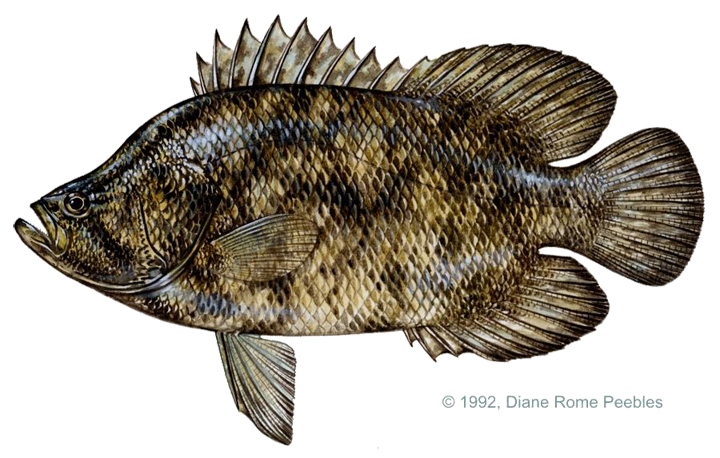Game Fish Identification Reference Guides
Tripletail
(Lobotes surinamensis)
(Lobotes surinamensis)

(Bloch, 1790); LOBOTIDAE FAMILY; also called buoy fish, buoy bass, blackfish, chobie, triplefin, flasher, lumpfish, snagdrifter, croupia roche, matsudai, dormilona, black perch, jumping cod
A cosmopolitan fish, tripletail live in tropical and subtropical seas worldwide. Their range is widespread through the Atlantic, Pacific and Indian Oceans.
They are deep bodied perch like fish with rounded dorsal and anal fins extending almost to the tail. At first glance they appear to have three tails, hence the most commonly used name, tripletail. Their color varies widely, from shades of yellow brown, to dark brown or black with ill defined spots and mottling.
They are most often found floating on or near the surface, hanging very near buoys (hence buoy fish or buoy bass), pier pilings or floating debris, or drifting along with currents imitating other buoyant objects. They can also be found lurking around bottom structure such as wrecks.
All types of tackle can be used but a 30 or 40 lb (15 or 20 kg) leader or shock tippet is desirable, because once hooked tripletail will almost invariably head back to the barnacle covered refuge where found. While live shrimp seem to be the preferred bait of many anglers, tripletails will hit dead baits, jigs, plugs or shrimp pattern flies and popping bugs.
They may look like a lazy, slow fish floating at the surface, but they can move quickly when they strike, and can exhibit surprisingly powerful lunges and occasional jumps when hooked. They also grow to a substantial size, possibly reaching a weight of 50 lbs (22.68 kg) and the white, fine textured fillets are excellent eating
A cosmopolitan fish, tripletail live in tropical and subtropical seas worldwide. Their range is widespread through the Atlantic, Pacific and Indian Oceans.
They are deep bodied perch like fish with rounded dorsal and anal fins extending almost to the tail. At first glance they appear to have three tails, hence the most commonly used name, tripletail. Their color varies widely, from shades of yellow brown, to dark brown or black with ill defined spots and mottling.
They are most often found floating on or near the surface, hanging very near buoys (hence buoy fish or buoy bass), pier pilings or floating debris, or drifting along with currents imitating other buoyant objects. They can also be found lurking around bottom structure such as wrecks.
All types of tackle can be used but a 30 or 40 lb (15 or 20 kg) leader or shock tippet is desirable, because once hooked tripletail will almost invariably head back to the barnacle covered refuge where found. While live shrimp seem to be the preferred bait of many anglers, tripletails will hit dead baits, jigs, plugs or shrimp pattern flies and popping bugs.
They may look like a lazy, slow fish floating at the surface, but they can move quickly when they strike, and can exhibit surprisingly powerful lunges and occasional jumps when hooked. They also grow to a substantial size, possibly reaching a weight of 50 lbs (22.68 kg) and the white, fine textured fillets are excellent eating












